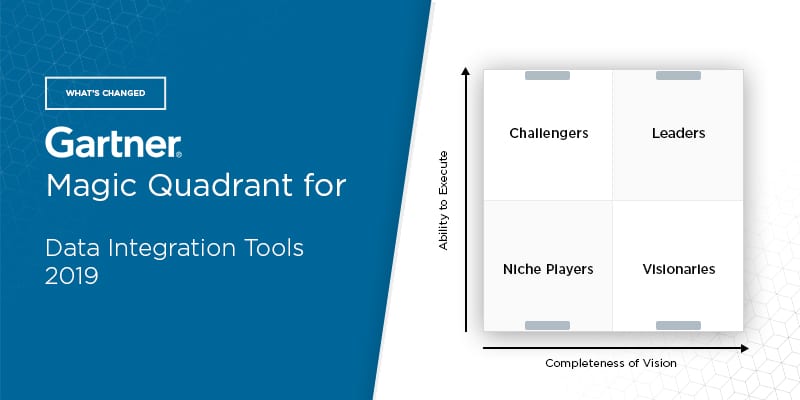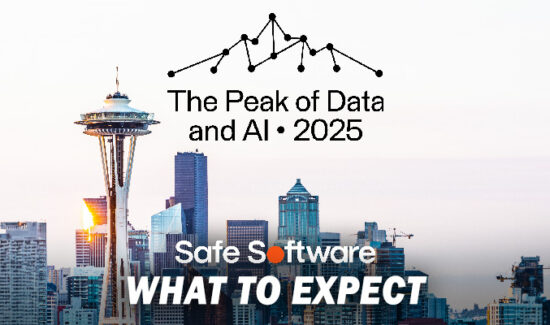What’s Changed: 2019 Gartner Magic Quadrant for Data Integration Tools


Analyst house Gartner, Inc. recently released the 2019 version of its Magic Quadrant for Data Integration Tools. The researcher defines data integration tools as encompassing “architectural techniques, practices and tools that ingest, transform, combine and provision data across the spectrum of data types.” Supporting the needs of organizational data consumption is the aim of data integration software, regardless of current market nomenclature. As a strategic planning assumption, Gartner projects that 80 percent or organizations will use more than one of the available data integration delivery types to solve for their use cases.
The best data integration providers offer products that enable construction and implementation of data access and delivery for a number of key use cases. The most common ones include integration and delivery for optimizing analytics, sourcing master data, ensuring data quality and consistency between applications, data acquisition and sharing, data migration, and support for data management and governance. New and emerging data integration use cases are highlighted by new requirements for hybrid and intercloud integration, as well as active metadata and augmented data management.
While some vendors specialize in moving data in bulk or batch, others are focusing on data virtualization, preparation, and message-oriented movement or data synchronization. As a result, prospective data integration software buyers can either seek tools with focused and targeted capabilities or a breadth of integration approaches. This is why significant submarkets have emerged in parallel to common integration products over the last few years. Gartner believes this represents a renewed focus on either vision or execution without addressing all the requirements of data integration software.
In this Magic Quadrant, Gartner evaluates the strengths and weaknesses of 16 providers that it considers most significant in the marketplace, and provides readers with a graph (the Magic Quadrant) plotting the vendors based on their ability to execute and their completeness of vision. The graph is divided into four quadrants: niche players, challengers, visionaries, and leaders. At Solutions Review, we read the report, available here, and pulled out the key takeaways.
This year’s Magic Quadrant features two new vendors. A staple of the parallel business intelligence space, Qlik makes its debut after announcing its intent to buy Attunity in February. The merger will see Qlik pull in Attunity’s partner network, expanding the company’s reach and strengthening its data lake management and cloud partnerships. Integration Platform as a Service leader and cloud integration technology driver SnapLogic is also included for 2019.
There is little difference in Gartner’s positioning of the major data integration players for 2019, with Informatica continuing to secure the top scores for both completeness of vision and ability to execute. The provider is on the cutting edge for augmented integration through the use of metadata-based AI and machine learning, though some of its reference customers would like to see portfolio complexity rationalization that aligns with common enterprise use cases. IBM and SAP retain close-proximity positions just to the southwest of Informatica on the graph.
SAS saw its position remain neutral in the leaders column, though the independent provider still touts the second-best horizontal standing of any vendor in this Magic Quadrant. SAS is investing heavily in self-service data preparation, including new data quality features with options for data streaming. Talend gained ground for completeness of vision, but it wasn’t enough to hold off Oracle’s move on the vertical axis. Though Talend recently added new machine learning-enabled suggestions to its Summer ’19 product, it remains in a dead heat with Oracle for the fifth-ranked overall spot on Gartner’s visual.
Microsoft and Denodo were virtually overlapping in Gartner’s 2018 Magic Quadrant, though Denodo has separated itself slightly with a rightward move toward the leaders column. Denodo is now just a stone’s throw away from challenging Talend and Oracle in 2020. Denodo is a data virtualization leader that helps its customer tackle use cases like logical data warehouse and data lake, data service marketplaces, and registry-style MDM. The provider offers a targeted product that reference customers use for connecting to diverse sources and federated data.
Information Builders has some competition in the visionaries bracket with SnapLogic’s addition to the report, but perhaps not until next year. Information Builders’ placement is identical to that of 2018, though the vendor continues to focus on developing an integrated environment for data integration that can operate with data preparation, MDM and pre-packaged vertical-specific tools. However, selecting Information Builders integration software is usually influenced by an existing relationship and use of other products within the vendor’s portfolio.
TIBCO Software and Syncsort are positioned as niche players in similar fashion to 2018, though the former has improved its standing with a northward move on the grid. TIBCO offers an expansive portfolio of data management and analytics products, and is no stranger to improving its products with strategic acquisitions. TIBCO supports both common and emerging data delivery styles, and reference customers scored it the highest of any provider in this report in regard to messaging and streaming data integration.
Adeptia, Hitachi Vantara and Actian round out the niche players and vendor-centric portion of the report. While Adeptia Connect offers expanded capabilities for large-file data ingestion and flexible pricing, metadata management is a weakness according to Gartner reference customers. Hitachi Vantara hangs its hat on data management support, IoT and edge computing functionality, some buyers want more clarity and definition surrounding the provider’s available products. Actian’s embeddable data integration tool is popular to those who value in-line statistics for data that crosses the platform.




















